Wenn Ihre Website wächst, müssen Sie möglicherweise Teammitglieder oder Auftragnehmer zur Bewältigung verschiedener Aufgaben hinzuziehen. Ob es um das Schreiben von Beiträgen, das Anpassen von Einstellungen oder die Bearbeitung von Kundenbestellungen geht, nicht jeder benötigt den gleichen Zugriff.
Es ist leicht, davon auszugehen, dass jeder neue Benutzer volle Administratorrechte erhalten sollte, aber das kann riskant sein. Viele Website-Besitzer haben auf die harte Tour gelernt, dass zu viele Zugriffsrechte zu versehentlichen Änderungen – oder schlimmer noch – zu Sicherheitsproblemen führen können.
Das ist so, als würde man den Schlüssel für das ganze Haus aushändigen, wenn man nur Zugang zum Vorgarten braucht.
Zum Glück verfügt WordPress über integrierte Benutzerrollen, mit denen Sie festlegen können, was jede Person auf Ihrer Website tun darf. Vom Schreiben von Blogbeiträgen bis zur Verwaltung von Plugins können Sie entscheiden, wer auf was Zugriff hat.
In diesem Leitfaden werden die Rollen und Berechtigungen der WordPress-Benutzer aufgeschlüsselt, damit Sie jedem Benutzer die richtige Rolle zuweisen können.
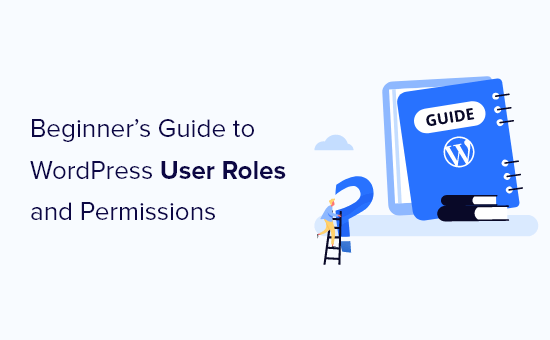
Was sind WordPress-Benutzerrollen und -Berechtigungen?
Betrachten Sie Ihre WordPress Website wie ein Haus. Nicht jeder braucht die Schlüssel zu jedem Zimmer. Manche Leute sollten nur die Eingangstür öffnen können, während andere vielleicht Zugang zur Küche oder zum Büro benötigen.
Mit den Rollen und Berechtigungen von WordPress-Benutzern entscheiden Sie, wer was auf Ihrer Website tun darf. Sie geben Ihnen die Kontrolle über Ihre Website und bewahren sie vor versehentlichen Änderungen oder Sicherheitsrisiken. Ein kluger Einsatz ist wie das Setzen klarer Grenzen – jeder erhält den richtigen Zugriff ohne unnötige Risiken.
Sie können Ihrer Website mehrere Benutzer hinzufügen oder sogar neuen Besuchern erlauben, sich über eine offene Registrierung anzumelden. Bevor Sie jedoch den Zugang gewähren, müssen Sie die richtige Rolle zuweisen.
Jede Rolle eines Benutzers verfügt über eine Reihe von Berechtigungen, die festlegen, welche Aktionen jemand durchführen kann. Einige Rollen erlauben es Benutzern, Beiträge zu veröffentlichen, während andere nur Inhalte lesen oder Einstellungen verwalten können.
WordPress enthält fünf Standard Rollen für Benutzer:
Brauchen Sie eine schnelle Möglichkeit, sie zu vergleichen? Dann schauen Sie sich die folgende Infografik an:
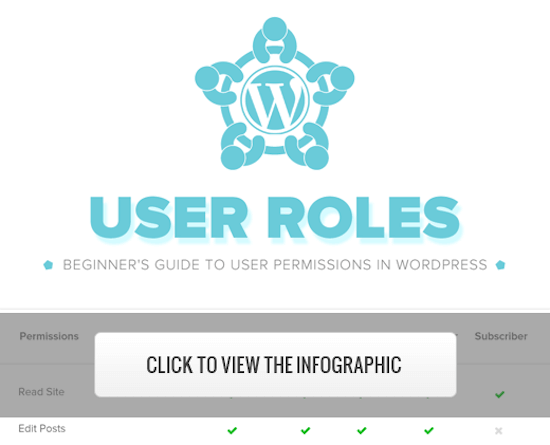
Wenn Sie es vorziehen, lesen Sie weiter, um eine Aufschlüsselung der einzelnen Rollen der Benutzer und ihrer Möglichkeiten zu erhalten.
1. Rolle des Administrators
Bei einer normalen WordPress-Website ist die Administratorrolle die mächtigste Benutzerrolle. Benutzer mit der Administratorrolle können neue Beiträge hinzufügen, Beiträge von beliebigen Benutzern bearbeiten und diese Beiträge löschen.
Außerdem können sie Plugins und Themen installieren, bearbeiten und löschen.
Vor allem aber können Administratoren Benutzer hinzufügen und löschen und Informationen über bestehende Benutzer, einschließlich ihrer Kennwörter, ändern.
Diese Rolle ist für Website-Besitzer reserviert und gibt Ihnen die volle Kontrolle über Ihre WordPress-Website.
Wenn Sie eine WordPress Website mit mehreren Benutzern betreiben, müssen Sie sehr sorgfältig darauf achten, wem Sie die Rolle des Administrators zuweisen.
Kann ich den Admin-Zugang mit einem Entwickler teilen?
Unserer Erfahrung nach ist es etwas sicherer, eine Staging-Website unter demselben Hosting-Konto zu erstellen. Es ermöglicht Entwicklern, die gleiche Webhosting-Umgebung zu nutzen, um ihren Code zu testen, ohne jedoch das Recht zu haben, etwas auf Ihrer Live-Website zu veröffentlichen.
Alternativ können Sie den Entwicklern eine leere Website unter demselben Hosts-Konto zur Verfügung stellen, damit sie daran arbeiten können. Auf diese Weise haben sie keinen Zugriff auf die Daten, die auf Ihrer Website gespeichert sind.
Weitere Informationen finden Sie in unserem Artikel über die Freigabe des Admin-Zugriffs für Entwickler von Plugins.
2. Rolle des Editors
Benutzer mit der Herausgeberrolle in WordPress haben die vollständige Kontrolle über die Inhaltsbereiche Ihrer Website.
Sie können jeden Beitrag auf der Website hinzufügen, bearbeiten, veröffentlichen und löschen, auch solche, die von anderen geschrieben wurden. Ein Editor kann auch Kommentare moderieren, bearbeiten und löschen.
Redakteure können die Einstellungen Ihrer Website nicht ändern, keine Plugins und Themen installieren und keine neuen Benutzer hinzufügen.
3. Rolle des Autors
Benutzer mit der Rolle des Autors können ihre eigenen Beiträge schreiben, bearbeiten und veröffentlichen. Sie können auch ihre eigenen Beiträge löschen, selbst wenn diese bereits veröffentlicht wurden.
Autoren können beim Verfassen von Beiträgen keine neuen Kategorien erstellen, aber sie können aus bestehenden Kategorien auswählen und Schlagwörter zu ihren Beiträgen hinzufügen.
Autoren können Aufrufe anzeigen, auch solche, die zur Überprüfung ausstehen, aber sie können keine Kommentare moderieren, freigeben oder löschen.
Sie haben keinen Zugriff auf Website-Einstellungen, Plugins oder Themes, so dass es sich um eine relativ risikoarme Benutzerrolle handelt. Die einzige Ausnahme ist die Möglichkeit, ihre eigenen veröffentlichten Beiträge zu löschen.
4. Mitwirkende Rolle
Benutzer mit der Rolle eines Mitwirkenden können neue Beiträge hinzufügen und ihre Beiträge bearbeiten, aber sie können keine Beiträge veröffentlichen.
Beim Verfassen von Beiträgen können sie aus bestehenden Kategorien wählen und ihre Schlagwörter erstellen.
Der größte Nachteil der Rolle des Mitwirkenden ist, dass er keine Dateien hochladen kann, so dass er seinen Beiträgen keine Bilder hinzufügen kann.
Die Mitwirkenden können auch alle Website-Kommentare einsehen, aber sie können keine Kommentare genehmigen oder löschen.
Außerdem haben sie keinen Zugriff auf Website-Einstellungen, Plug-ins oder Themes, können also keine Einstellungen auf Ihrer Website ändern.
5. Rolle des Teilnehmers
Benutzer mit der Abonnentenrolle können sich bei Ihrer WordPress-Website anmelden, ihre Benutzerprofile aktualisieren und ihre Passwörter ändern.
Sie können keine Beiträge schreiben, keine Kommentare anzeigen und auch sonst nichts in Ihrem WordPress-Verwaltungsbereich tun.
Diese Benutzerrolle ist besonders nützlich, wenn Sie eine Mitgliederseite, einen Online-Shop oder eine andere Seite haben, auf der sich Benutzer registrieren und anmelden können.
Wenn Sie ein individuelles Anmeldeerlebnis für Ihre Besucher schaffen möchten, lesen Sie unsere Anleitung zum Hinzufügen einer Frontend-Anmeldeseite und von Widgets in WordPress.
Bonus: Super-Administrator-Rolle
Diese Benutzerrolle ist nur in einem WordPress-Multisite-Netzwerk verfügbar.
Benutzer mit der Super-Admin-Benutzerrolle können Websites in einem Multisite-Netzwerk hinzufügen und löschen. Sie können auch Plugins und Themes installieren, Benutzer hinzufügen und netzwerkweite Aktionen in einer WordPress-Multisite-Einrichtung durchführen.
Stellen Sie sich das so vor, als hätten Sie einen Administratorenzugang zu jeder Website im Netz.
Anpassen bestehender Benutzerrollen und Berechtigungen in WordPress
Die Standard-WordPress-Benutzerrollen bieten Funktionen, die für die meisten WordPress-Websites und -Blogs geeignet sind.
Wenn Sie z. B. eine Zeitschriften-Website betreiben, kann die Rolle “Redakteur” leitenden Mitarbeitern zugewiesen werden, die Benutzerrolle “Autor” kann für Nachwuchsautoren und die Rolle “Mitwirkender” für Gastautoren vorgesehen werden.
Manchmal möchten Sie jedoch die Berechtigungen und Berechtigungen, die der Rolle zugewiesen sind, individuell anpassen, um die spezifischen Anforderungen Ihrer Website zu erfüllen.
Like die Standard-Autorenrolle, die Benutzern die Möglichkeit gibt, ihre Beiträge zu veröffentlichen und auch zu löschen, möchten Sie vielleicht die Berechtigungen entfernen, mit denen Autoren ihre Beiträge löschen können.
Es gibt einige Plugins, die Ihrer Website bestimmte Rollen hinzufügen, wie z. B. ein Plugin für die Rolle des Kommentar-Moderators.
Der einfachste Weg, die Rollen Ihrer WordPress Benutzer individuell anzupassen, ist jedoch die Verwendung des Plugins Members. Damit können Sie Benutzerrollen auf Ihrer Website erstellen, verwalten und ändern.
Als Erstes müssen Sie das Plugin aktivieren und installieren. Weitere Einzelheiten finden Sie in unserer Schritt-für-Schritt-Anleitung für die Installation eines WordPress-Plugins.
Nach der Aktivierung haben Sie einen neuen Menüpunkt namens “Mitglieder” in Ihrem WordPress-Administrationsbereich.
Gehen Sie zu Mitglieder ” Rollen und klicken Sie auf die Benutzerrolle, die Sie bearbeiten möchten.
In diesem Beispiel wird die Rolle “Autor” bearbeitet, aber Sie können die für Ihre Bedürfnisse beste Rolle wählen.
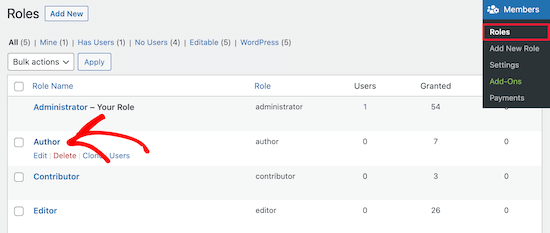
Dadurch gelangen Sie zu einem Bildschirm, auf dem Sie die Funktionen für diese Rolle vollständig anpassen können.
Um eine Berechtigung für die Rolle zu entfernen, markieren Sie die Box “Verweigern”. Wenn Sie eine neue Berechtigung hinzufügen möchten, aktivieren Sie die Box “Gewähren”.
Hier markieren wir das Kästchen “Verweigern” für die Benutzerfunktion Beiträge löschen.
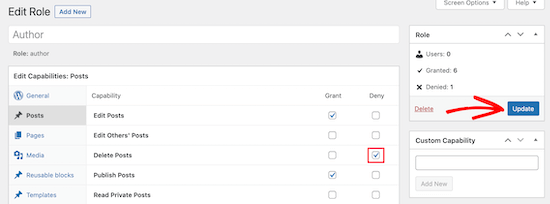
Wenn Sie ein Kästchen für eine verfügbare Rolle nicht ankreuzen, verfügt der Benutzer nicht über diese Fähigkeit.
Sobald Sie die Anpassung Ihrer Rolle abgeschlossen haben, klicken Sie auf die Schaltfläche “Aktualisieren”.
Die Änderungen, die Sie vornehmen, gelten automatisch für alle vorhandenen Benutzer mit dieser Rolle und für alle neuen Benutzer, denen die Rolle zugewiesen wird.
Wie man benutzerdefinierte Benutzerrollen in WordPress erstellt
Außerdem können Sie in WordPress vollständig benutzerdefinierte Benutzerrollen mit einzigartigen Funktionen erstellen.
Hierfür verwenden Sie das gleiche Plugin wie oben.
Navigieren Sie einfach zu Mitglieder ” Neue Rolle hinzufügen, und geben Sie Ihrer neuen Rolle einen Namen.
Sie können zum Beispiel eine Entwicklerrolle erstellen, die Sie einem WordPress-Entwickler mit bestimmten Berechtigungen zuweisen können.
Die linke Spalte enthält verschiedene Abschnitte mit Listen der verfügbaren Funktionen. Wir wählen die Registerkarte “Erscheinungsbild” und fügen dann Funktionen zum Bearbeiten, Installieren und Aktualisieren von Designs hinzu.

Klicken Sie anschließend auf die Schaltfläche “Rolle hinzufügen”, um die Benutzerrolle zu speichern.
Anschließend können Sie einen neuen Benutzer anlegen und ihm die neue Benutzerrolle zuweisen.
Gehen Sie dazu auf Benutzer ” Neu hinzufügen und geben Sie Ihre neuen Benutzerdaten ein.
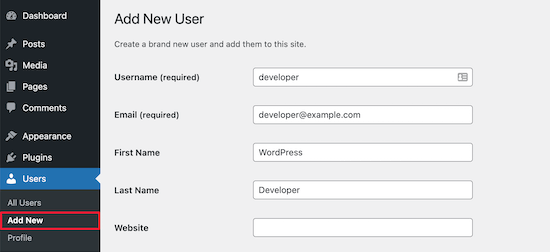
Am unteren Rand des Bildschirms sehen Sie einen Abschnitt “Benutzerrollen”.
Jetzt können Sie die Boxen für die Rollen ankreuzen, die Sie dem neuen Benutzer zuweisen möchten, und dann auf den Button “Neuen Benutzer hinzufügen” klicken.
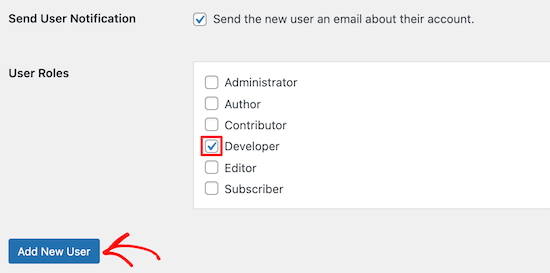
Sie haben nun eine neue benutzerdefinierte WordPress-Benutzerrolle erstellt und diese einem neuen Benutzer zugewiesen.
Weitere Einzelheiten finden Sie in unserer Anleitung zum Hinzufügen neuer Benutzer und Autoren zu WordPress.
Wenn Sie eine WordPress-Benutzerrolle erstellen möchten, die nur für die Moderation von Kommentaren vorgesehen ist, lesen Sie unsere Anleitung, wie Sie Blog-Benutzern die Moderation von Kommentaren in WordPress erlauben.
Tipps & Anleitungen zur Verwaltung der Rollen von Benutzern in WordPress
Wenn Sie sich fragen, wie Sie die Verwaltung von Benutzerrollen auf Ihrer WordPress-Website effektiver gestalten können, dann helfen Ihnen diese zusätzlichen Ressourcen vielleicht weiter.
- Plugins zur Benutzerverwaltung für WordPress (kostenlos + kostenpflichtig)
- So erlauben Sie Editoren, nur bestimmte Seiten in WordPress zu bearbeiten
- Hinzufügen einer Rolle als SEO Editor in WordPress
- Wie man Benutzer nach erfolgreicher Anmeldung in WordPress umleitet
- Autoren auf eine bestimmte Kategorie in WordPress beschränken
Wir hoffen, dass dieser Artikel Ihnen geholfen hat, die Rollen und Berechtigungen der Benutzer zu verstehen. Vielleicht interessiert Sie auch unsere Anleitung, wie Sie Autoren am Löschen von Beiträgen hindern können, oder werfen Sie einen Blick auf unsere Anleitung zur Beschränkung von Autoren auf ihre eigenen Beiträge.
Wenn Ihnen dieser Artikel gefallen hat, dann abonnieren Sie bitte unseren YouTube-Kanal für WordPress-Videotutorials. Sie können uns auch auf Twitter und Facebook finden.





Tammy
What role is suggested if you want someone to be able to view/download the analytics of a woocommerce site but not be able to change and/or update the content of the site otherwise? Do the basic roles cover that or is that a custom role?
WPBeginner Support
You would likely need to create a custom role for that functionality
Admin
LDB
Why do all articles on user permissions for WordPress never talk about what can be done with ‘pages’?. Seems like such a glaring omission from these articles. Am I missing something? Why do no articles not give info about permission related to building and editing pages?
WPBeginner Support
If you take a look at the infographic we cover which roles can modify pages
Admin
Traci
I am building a website in wordpress for a company. They want a dedicated page for sales or specials but they want to be the one’s handling updating that page each week. Can I give them permission only to post pictures and write add information for the sale items?
WPBeginner Support
It sounds like you would want to set them as the author role and set them as the author of that page.
Admin
Harish
Is there any limitation for user roles count?
WPBeginner Support
No, but you would want to ensure you are not adding roles for every user normally as multiple users can use the same role.
Admin
Maame
Hi,
Is it possible to customize the role of a shop manager? I would like to make some features accessible to them
WPBeginner Support
Yes, we cover the default roles in this guide but more roles can be added or modified
Admin
DannyO
Great writeup. Very close to what I was searching for.
Mine is a bit different,
I have a custom made plugin which I want to assign someone to manage the role. He needs to be entering data on a daily basis in dashboard of this custom plugin. But under the Type-Specific Capabilities, I dont see the name of this plugin. How can I achieve this then, when I cant see the custom plugin name?
WPBeginner Support
You would want to reach out to the plugin’s creator for what permissions are required to be able to use your plugin.
Admin
Katherine
Hi! I work for a site and I’m was assigned Editor. But for some reason, I can’t delete drafts, published articles, or media from Gallery that aren’t mine. The Trash/Delete option just isn’t anywhere on-screen. Is there anything I can do?
WPBeginner Support
You would want to reach out to the admin of the site to ensure there haven’t been any changes to the permissions for your role.
Admin
luka sheklashvili
Hi,
We have a website where is possible to buy food
We have customers and also we have accountant
which premmision will be best for accountant to do his/her work
we are using woocomerce platforme of ecomerce
WPBeginner Support
You would want to take a look at the default WooCommerce roles added and you can add or modify the role depending on the access you want to give.
Admin
Kshitij Gajam
Hi,
Thanks for the great article! it is neatly structured and presented.
I would like to know is it possible to restrict access up to 3 blogs for users who dont subscribe to the website. Only after subscribing they get full access. If yes, how can I do it? Is there a plug in or I have to code?
WPBeginner Support
For what you’re looking for, you would want to take a look at membership plugins below and you would need to reach out to the support for what you’re wanting to use for if they have that available.
https://www.wpbeginner.com/plugins/5-best-wordpress-membership-plugins-compared/
Admin
Felicia Kay
I have recently started a new job with a local law firm and we have purchased a form building tool for our WordPress site. My role permissions have been set to Editor, am I able to access it as an editor to build the new form(s) we need?
WPBeginner Support
It would depend on the specific plugin. If you reach out to the plugin’s support they should let you know what permissions are needed for using the plugin
Admin
lynda
I have been a WordPress user for many years and decided several months ago to combine two blogs. At that time I added the user name of the other blog as a user on my primary blog. Now that second user appears as the author of posts. It appears as the writer of replies to comments. How do I change this?
WPBeginner Support
If you do not want your additional user to be on the site you can delete that user and attribute all of their content to your a different user
Admin
Maude
Hi, do you know if there is a way to create a user who will have access to everything, but can edit nothing. I want to show someone how my website is built so we can talk about it, but I want to be sure he can’t mess anything up.
WPBeginner Support
That would heavily depend on your site and the plugins you are using, you may want to send screenshots or share screens for what you are wanting.
Admin
Jerusha
Hi, I have just started my blog. And installed a new theme. My site is not even live yet … it still had the ‘coming soon” page, however today I discovered I have 308 subscribers under the ‘user’s title on my dashboard… how is that possible?
WPBeginner Support
Your site may be allowing user registration, for more on that you would want to take a look at our article here:
https://www.wpbeginner.com/beginners-guide/how-to-allow-user-registration-on-your-wordpress-site/
Admin
Imran
And what if a disgruntled author goes to “edit” her post and then removes all the content and then click on “update” button.
This would be a rare case but possible even if you disallow her to “delete published” posts.
WPBeginner Support
If you are concerned about that, you could disable the ability to edit published posts
Admin
Segun Wonda
Hello, thank you for this great article.
I have a question please.
After modifying my author role to stop author from deleting their own post with this plugin, will the modification still be active when I disable or delete the plugin?
WPBeginner Support
Yes, your changes should still be active when you remove the plugin.
Admin
sam thandi
i was searching for one of your articles in which you showed how to create user like Editorial Staff can you please give me link to that article. thanks
WPBeginner Support
It would depend on what you mean. If you’re wanting more editorial options you could take a look at our article here: https://www.wpbeginner.com/plugins/how-to-improve-your-editorial-workflow-in-multi-author-wordpress-blogs/
If you wanted to hide the author’s name we have our article here:
https://www.wpbeginner.com/wp-themes/how-to-remove-author-name-from-wordpress-posts/
Admin
Pablo
I can see that there are more user categories now, in addition to the 5 mentioned here. Participant, Moderator, Spectator… Cant see the permissions for these! Any ideas where to find them?
WPBeginner Support
If you have other plugins that add user roles those would likely be why you have the extra roles
Admin
Infoneter
Nice and useful information. thanks
WPBeginner Support
You’re welcome
Admin
Kirk Bullen
Great post.. And great site. It’s my ‘Go To’ site, for everything I need, and have learnt so much.
What I want to do, is create a Movie Mod User. So that they can Add Movies/Shows. But I don’t want to give all Admin permissions. They would only require to use the Plugin used to add these Movies/Shows. All it.would require them to do, is use the Import Movie/Show. Then once added, have the ability to edit the Movie/Show. So that they can add the Movie/Show Collection/Genre.
Is there a plugin available that you know of, that gives permissions to use selected Plugin Admin abilities? I have tried Editor User. But it doesnt show the ‘Import’ option.
Any advise is greatly appreciated.
WPBeginner Support
It would depend on what you are using to import the movies, if it is a plugin you should be able to reach out to the plugin’s support for what permission is required to import the movie/show.
Admin
Steveo
Users >> Capabilities does not exist. Got another idea?
WPBeginner Support
You may want to ensure that the plugin was activated successfully on your site.
Admin
sultan haider
I have school chains in multiple cities and i want to each school have
their login and password and add students in own schools records and
admin have access all schools records.
Its possible with wordpress or not.
WPBeginner Support
It is possible but you would likely need to have a custom plugin created to do something that specific.
Admin
Tony
Suggest you use multisite capability, each school can have their own subdomain.
Emzee
How to check what permissions I have as a user on wordpress site please? Sorry am a beginner?
WPBeginner Support
Hi Emzee,
Using the capability manage enhanced you can see what permissions a user has on your site.
Admin
shubhangi
Great post now i can ad more author without confusion thanks friend
Mithilesh Yadav
How to send notification mail by Guest User in WordPress
Marianne
Good day!
Thanks for the explanation. I was wondering is there also a date stamp when the user has registered?
regards,
Kagan
i am using wholesale plugin. we want open manuel order from order woocommerce dashboard
But when i add product wholesale prices are not shown. is it possible to make this wtih user roles plugins. if so which one should we use
thank you
chintan
Hi i want make a two type of login page first is customer and second is Service provider (like a amazon seller).
service provider uplode it’s services , and it can edit it’s services.
how i do that?
beth
Hi. I created some new users but they have yet to receive their email notification. How long does it take for that to be generated?
LaVonne Carlson
Is it possible to setup a user with permission to edit only a particular page? I’m running a website for a Boy Scout troop, and I want the boys to be able to upload and rearrange photos on the gallery page, but not make any other changes to the site.
Gulfam
I’ve also problem related to your question, want to allow user only on specific plugin and page to post things.
Fahad Rafiq
How can we remove underscore from users name in wordpress users tab?
Like if name entered is First Second, it will appears as First_Second.
Any fix.?
John
Whenever my writers try to past an iframe into their stories it vanishes when saving. From a little bit of testing this occurs up to Editor level which also gives publishing ability — which I don’t want them to have.
I’ve got both adminimize and user role editor installed. Staff writers have a custom user role editor setting of Staff Writers.
How can I overcome this limitation on inserting iframes?
Thank you
WPBeginner Support
Hey John,
The capability to add iframes is part of unfiltered_html capability. However, allowing user roles the ability to add unfiltered html is too risky and not recommended. You should look for other ways to manage this. For example, if this iframe embed is from a third party service provider, they they might already have a WordPress plugin.
Admin
John
Thank you. Ordinarily I would agree. But these are inhouse writers who need this capability. The most common is Facebook video embeds getting the iframe from Embedded Video & Live Video Player.
We also embed YouTube and other video in the body of the stories often and this explains why the html table that has been prepared for them to use by simply replacing the URL doesn’t work.
The rest of what the different level of access – editor, copy editor, photo editor, contributor, and staff writer can see and access is regulated using adminimize and user role editor.
What is the risk of giving unfiltered html access to inhouse staff?
Thank you
WPBeginner Support
Hey John,
With unfiltered html capability, users will have the ability to add malicious code which could get executed as soon as the post content is saved.
John
Ok. Thank you. That won’t be an issue in this instance. But very useful to know.
Akhil
Is it possible to delete a post by another author.?
WPBeginner Support
Hey Akhil,
If you are an administrator or editor on that site, then yes you can delete posts created by another author.
Admin
Jake
I am not getting a lot of “email subscribers” via the subscribe widget to my blog but I do receive a lot of “New user registration” notifications from WP of people that are set up as their user role as “subscribers” and so my WP admin has a list of these people and their email addresses.
As far as I can tell, when I create a new post, no one with the user role “Subscriber” is being notified. Why else does WP give me their email address if not to notify them? Perhaps I am doing something wrong? How do I notify the hundreds and hundreds of people in this list?
WPBeginner Support
Hi Jake,
Please see our guide on how to add email subscriptions to your WordPress blog.
Admin
Imtiaz Ahmed
hi, I have many Editors on my website, how I can strict, I mean editors are not able to edit Admin post. I want this on my website
Regards:
Imtiaz Ahmed
WPBeginner Support
Hey Imtiaz,
The editor user role gives users permission to edit any posts. You should change their user role to author or contributor. You can also edit permissions of a user role or create new user roles using plugins.
Admin
Gary Wicks
I have a question if I have 300 subscribers what does that mean? Does it mean people subscribed to make a comment? I have no idea where these came from as I only have a few actual comments posted. Does this mean they were all spammers that Akismet software rejected? So the comments did not show but they are all in my users list as subscribers to make comments?
Or is this rss feed or what is it?
Steve Root
The role attribute selection on my theme has both an Allow and a Deny column. If a particular attribute is only enabled when checked what is the purpose of the Deny column (twenty-sixteen)?
deppak
Hi there,
Great post!
I created a custom role cloning the “administrator”, is it possible for administrators to change between the two? I can see the administrator can change all others’ role, but can it change its own through the back-end dashboard/menu?
Thanks!
Anne Cohen
Hi. Thank you for the post! Very helpful, but one more question….
Can Contributor writers DELETE their articles when they’re published?
What about when they’re pending?
Let’s say they had a change of heart? I just noticed a contributor alter an article that I was already editing/pending. I didn’t think that was possible.
Abhiney
Hi,
I am facing issues with the user creation. I am looking to create an editor for my website but despite deactivating all plugins, changing passwords etc,for the new user – when I try to login in through the ‘New User’ credentials it says – “Sorry, you are not allowed to access this page.”
Can you please help.
Debbie N.
Can I give permission to use a backup plugin but not other plugins? I see you can add more capabilities but I can’t figure out how to set it up for that. Thanks for any help.
Obed Aikins
Hi, nice post, very useful. i’m a college student developing a site for publishing hostels information and also book into it using wordpress. i want to create custom agent/landlord roles in WP. please help
Stuart
Users with the subscriber user role can login to your WordPress site and update their user profiles. They can change their passwords if they want to. They cannot write posts, view comments, or do anything else inside your WordPress admin area.
This user role is particularly useful if you require users to login before they can read a post or leave a comment.
I don’t understand this. So if a subscriber is logged in can they or can’t they comment on a post?
WPBeginner Support
Yes they can comment on a post.
Admin
Alan Jordan
This was really helpful. Thank you.
Jez Butler
Great descriptions – thanks! Is there any way to set an Administrator role for individual sites on a multisite install? TIA, Jez
deepak
hi
i am collage student and i make the website on school on wordpress so i want to create the dynamic menus that was static.
how can we do?
dbutler
Please you clarify your question.
denarius
Hi Deepak,
I would like to help you. What do you mean by “create the dynamic menus that was static”? Please clarify your question.
Thanks
Mike Mullin
Can you customize the Admin role (I’d live to remove some of the capabilities like adding/removing Users) within the standard WP install or do you need a plugin like this?
Amruta
Hi,
I wants to upload video in my Website but the video size is 102 MB,
And i don’t want to show that suggestion video which shows after end the video, like You tube.
Is you have any idea about the Plugin or Site so i can link my video in website ?
Thank You
Susan
Could you change the Editors role to add/edit users. The permissions to the Admin role can be overwhelming.
WPBeginner Support
Yes you can do that.
Admin
olivia
Is it worth mentioning that the Author Role can’t create/edit/delete Pages?
rcanu
Yeah I think that will be helpful! It will also be helpful if we can enumerate page levels of access for other page roles.
Blair Jersyer
Hi,
You wrote two time “5” in role list.
Nice post anyway.
WPBeginner Support
Thanks for notifying us. We have fixed the mistake.
Admin